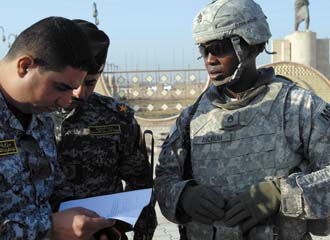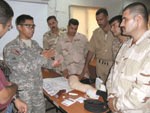Operations Before and After the Drawdown
 |
Staff Sgt. Travis Ancrum, USA (r), 5th squad leader with the 501st Military Police Company, Division Special Troops Battalion, 1st Armored Division, United States Division-Center (USD-C), discusses a rendezvous location with Iraqi Army soldiers in Baghdad. |
Combat operations in Iraq officially ended last year, but the troops of the U.S. Army’s 1st Armored Division continued contingency operations, working with Iraqis to overcome remaining challenges and to complete necessary missions. As other units left the battlespace, the division’s signal soldiers inherited responsibility for more geographic area, requiring them to adapt their methods and equipment accordingly, until the division, too, returned home last December.
Lt. Col. Randolph Wardle, USA, the 1st Armored Division signal officer, explains that he and a large staff oversaw the communications in Baghdad and Al Anbar province as well as some operations in Qatar. “I actually had more Army staff than I had contractors because I chose to have my soldiers do the work,” he says. “They’re extremely competent. It’s amazing what the Army has put out in the last couple of years in terms of smart soldiers.”
The intelligence he lauds was put to good use during the division’s deployment as the troops managed the Joint Network Transport Capability and put in various line-of-sight and other networks. Col. Wardle says his unit monitored many of the same services found in any U.S. city. But unlike companies back home, the soldiers also worked with Iraqi signal officers and soldiers, advising and training them on subjects such as radio networks and automation.
One of the big issues that U.S. soldiers helped the Iraqis handle was information assurance, including how to use antivirus software. Col. Wardle says that the ministries of Interior and Defense are both progressing well with their cybersecurity efforts. In addition to the ministries and their subordinate organizations, the 1st Armored Division as United States Division-Center worked with the Iraqi Federal Police as well as personnel that the colonel describes as Iraqi border patrol. The 1st Armored fills the role of division command element for the Baghdad and Anbar provinces. Col. Wardle says his troops helped the Iraqis by explaining new capabilities and emphasizing how they could implement those with what they already had in their possession. “We taught them how to use the capabilities and how to use that in a combat environment,” he explains.
This advise-and-assist role remained consistent during the U.S. unit’s deployment, both pre- and post-troop drawdown. “I don’t think it’s a new thing by any stretch of the imagination,” Col. Wardle says. He adds that U.S. troops really have been providing advice since 2004 and similar activities are carried out in Afghanistan. Col. Wardle has served multiple tours in Iraq and Afghanistan, including serving as a combat G-6 in Tikrit. One of the big differences he noticed between his tours is how much work the Iraqis are completing on their own now and their increase in initiative. “They’re going out there, getting it done,” he says. Members of the native population are working to educate themselves in the communications and information technology field. The colonel explains that he met Iraqis at the Ministry of the Interior who have more certifications than he does.
Overall, the signal troops’ mission experienced little change during their year in Iraq other than the added responsibility for Al Anbar province after the end of official U.S. combat operations. The soldiers took on the new territory without any addition of personnel, managing the increase by using Joint Network Node systems, fiber optics and line-of-sight systems.
 |
Sgt. 1st Class Melvin Bautista, USA, (2nd from l), clinical operations noncommissioned officer with the division surgeon’s office, 1st Armored Division, USD-C, teaches Iraqi students in a first-responder course how to use an intravenous infusion system at a Ministry of Defense training facility in Baghdad. |
To achieve those benefits, warfighters often worked directly in harm’s way. “We had soldiers who went out to some of the most dangerous places in Baghdad and made this work, made this happen,” Col. Wardle says. The effort took place over a two- to three-month period during which the troops added a substantial number of systems, though the Army requests exact numbers remain unpublished. Aside from the danger, Col. Wardle explains, one of the biggest hurdles to the networks’ set-up was waiting for rides to the installation areas.
Another technology that provided a boost to the soldiers was the Host Based Security System (HBSS), which helped improve information assurance. Col. Wardle explains that the HBSS itself is not a new technology, but that the Army has not employed it for long. The system helps detect a range of cyberwarfare problems from dangerous websites to the connection of various devices into a computer. After implementing the system, the division saw a drop in viruses from about eight to 10 a week down to zero.
Col. Wardle has a suggestion for how the military can further improve information sharing in Iraq: The Army can use more satellite bands than Ku and Ka, the primary ones his troops employed. He says that the more that satellites hit off different bandwidths, the more megabytes troops can access. “More is better,” he states.
One of his goals in theater was to provide the leaders up his chain of command with more bandwidth than they expected so they were unaware when equipment changed or an alternate connection path was used. “You have to oversaturate the network,” the colonel explains. By the time his unit left, it had increased the backup capabilities in Iraq, helping to ensure successful communications. Col. Wardle said his boss supported him when he said the Army needed the new networks, and through that support his staff was able to make the improvements.
The colonel also addressed the issue of expectation management, which he says is an impetus to become better. “It’s my job to give the boss more than he can handle when it comes to megs, when it comes to capabilities,” he explains. In Iraq, he worked to make sure warfighters could connect to computers, radios and aircraft and talk every single time. “I haven’t reached my expectation yet,” the colonel states.
Because technology travels so fast, there will always be more to do, and there will always be more to give the warfighters to ensure their lives are safe. Col. Wardle explains that those who have been on the wrong end of communications during a trouble situation understand “it’s a bad feeling.” He adds that if anyone wants to know how important communications on the battlefield are, all they need to do is look at a soldier’s family picture. “You have to make sure that these guys get home every day,” Col. Wardle states. “That’s what makes this important every day.”
Despite their potential value, sometimes those new technologies require adjustments. The colonel says he was not a fan of the command post of the future (CPOF) when it first deployed. “It was more technical than I wanted it to be,” he explains. “But nowadays, with the amount of bandwidth we have, the CPOF is an incredible technology.” Another advancement he touts is a system that enables users watching video from a UAV flying over a ground vehicle, for example, to show a map with an arrow pointing to the vehicle the aircraft is following. “That’s a heck of a capability,” Col. Wardle says. “But you wouldn’t have it if you didn’t have the bandwidth.”
Even with all the technology the 1st Armored Division enjoyed, and all the capabilities enabled by the work of its signal soldiers, Col. Wardle has a wish list of items he could have used in Iraq and still would like to see. One is a way to provide power that all devices rely on without the surges that burn up equipment over time. “It’s all about electricity,” he shares. At outposts such as Fallujah and Ramadi, troops use generators, which results in dirty power, also known as power spikes. Col. Wardle says that if he could invent one thing, it would be a device to clean up dirty power in a combat environment. He acknowledges that troops will never receive consistent power, but he would like a box that would take dirty power in and adjust it so that by the time it reaches a computer, the source is consistent. “That’s what we need,” the colonel says. “That’s the key to it all.”
Also on the colonel’s list is a desire for signals intelligence capability on every UAV. He says that only some of the aircraft currently are equipped for that role, but installing the capability on all the assets would benefit warfighters.
Industry can assist Col. Wardle by recognizing the value of his soldiers. He says that in his 24 years of duty he has never seen such smart personnel or seen troops with such initiative. “These kids pay their own money to get training and certification so they can get better at their jobs,” he explains. He also shares that he has had no lack of re-enlistments, but that he would like to see the U.S. work force harness this expertise. “Take what they know; take their knowledge and discipline; hire these kids; and you’d be amazed what they can do,” Col. Wardle states.
He believes his troops could work for the large software companies or even in a fields they know little about, because they would learn and then be successful. Col. Wardle also speaks to their patriotism, explaining many of the soldiers were children when the September 11 terrorist attacks occurred, and they joined the military because they have pride in their country, parents, towns and more. “They’re just great Americans,” he states. “They should be given opportunities when they get out.”
WEB RESOURCES
U.S. Army 1st Armored Division: www.1ad.army.mil
DISA Host Based Security System: www.disa.mil/hbss




Comments